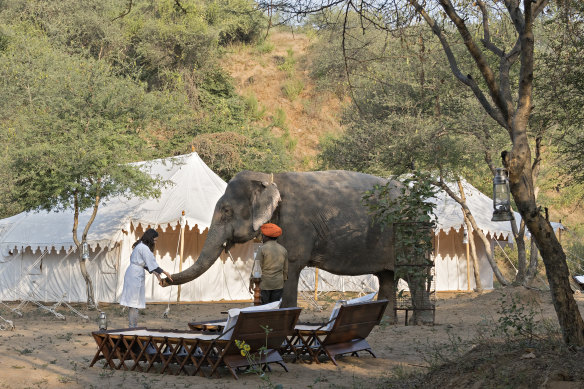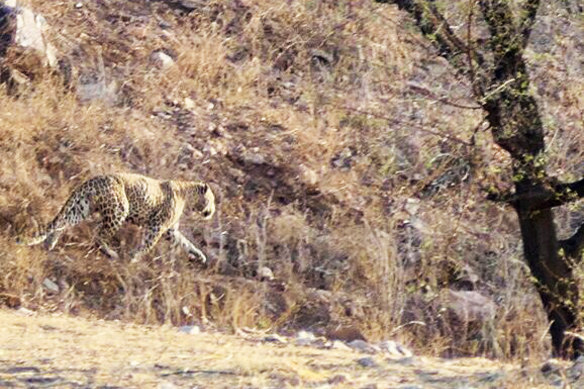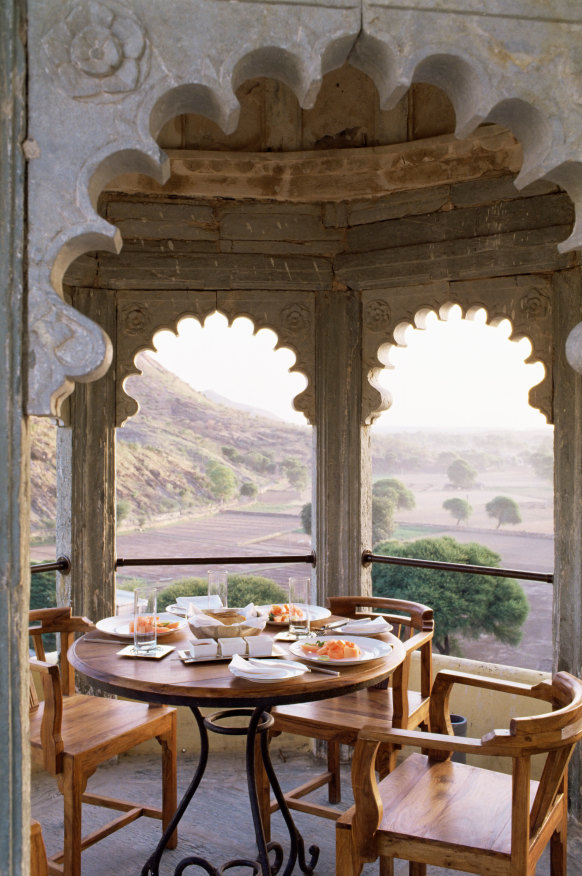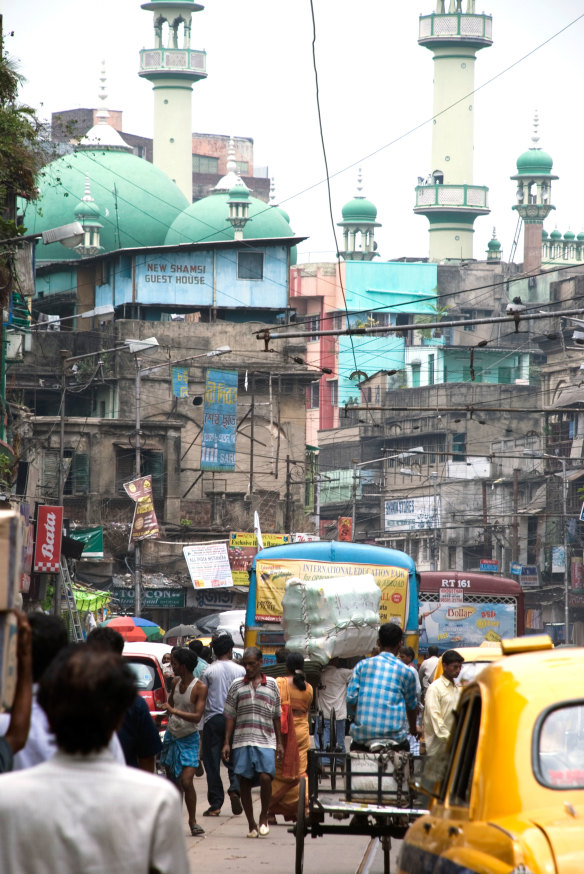This was published 5 months ago
‘Like Venice in high season’: The Indian city that’s going off
It’s always a risk to revisit a first love – but a return to the jewel in India’s crown is a revelation.
By Brook Turner

Dera Amer, a 73-hectare wilderness camp for rescue elephants an hour from Jaipur.
We weren’t climbing to the hunting tower to hunt. Sunrise over the waking village was the lure: wisps of smoke drifting up along with strains of Hindi pop, the Raas Devigarh palace glowing on the hill opposite like a big, squat croquembouche.
Local lords used to snipe at passing wildlife from this crenellated tower, my guide, Himmat, tells me. For us, however, it’s purely picturesque, a rook from some long-lost chess game. Yes, we’re in classic leopard country, but Himmat hasn’t seen one in the 100 or so trips he’s made, he assures me – then stops dead.
When I look behind me, he’s staring, perfectly still. “Over there,” he whispers, and I see a large male leopard slouching away from the tower he’s made his lair. Raising my iPhone – a reaction as instinctive as it is comic – I begin clicking randomly; catching a single shot of a flank, tawny as the light, before he merges with the rocks and disappears.
What follows is just as instinctive. We stand for a moment, then silently turn back. Though neither of us says it, we’re shaken: that cat was huge, almost tiger-sized; the top of a hill is the shortest bit to circumnavigate and – hunted turned hunter – he was moving.
Himmat has now seen his leopard. For me, too, a couple of lingering questions are beginning to be answered. First, wild leopards still roam India, something I’d wondered about while tramping on past trips through the eerily quiet forests of the Kumaon, carpeted in pine needles, animate with a sense of watching. Later Googling confirms leopard numbers are in fact on the rise, and the highest concentration is just beyond our current perch in the Aravali Hills outside Udaipur.
‘Over there,’ he whispers, and I see a large male leopard slouching away.
Secondly, India itself remains wild, capable of conjuring magic on a daily – or hourly – basis. It’s that larger question I have come back to answer, 15 years after my last trip and more than 40 years since I first visited Rajasthan, described as the jewel in the crown of what is more like a continent than a single country.
It’s always dangerous to revisit a first love, particularly when it hasn’t disappointed in the interim. In the years since, I’ve ranged around the Himalayas, staying in village huts, visited the martian landscape of Ladakh, known as “Little Tibet”, and the ruined medieval capital of Hampi, a city greater than Rome in its day and my pick of all India’s glories. Over that time, India’s international tourist numbers have increased more than tenfold, from just over a million in 1981 to almost 18 million pre-COVID-19, concentrated largely in Rajasthan. A decade ago, too, Narendra Modi’s Hindu-nationalist BJP party came to power.

Leopards still roam freely in India, with the highest concentration just outside Udaipur.Credit: Kendal Hill
Fairly sure nothing could survive that onslaught, I’ve avoided Rajasthan on subsequent visits. Which makes Udaipur in April, as the off-season begins, a revelation. Not least the Lake Palace, built by Maharana Jagat Singh II in the 18th century as a pleasure palace at the centre of Lake Pichola.
India’s palace hotel revolution started in the late 1970s, when princely families turned their homes into museums to minimise tax and into hotels to attract new government loans. In 1981, the Lake Palace looked out at the empty banks of a sleepy town. The 1983 James Bond movie Octopussy would make it internationally famous as the lair of its titular anti-heroine. The film still screens every night in town.
These days, from the Lake Palace terrace at sunset, Udaipur looks like Venice in high season. The Disney cupolas of the Leela Palace, which opened in 2009, dominate the bank in front, while to its left is the grander-still 20-hectare Oberoi Udaivilas – which opened in 2002 and was declared the best hotel in the world in 2015. In between, a tract of hoarding as huge again announces a new entrant to Udaipur’s weddings-parties-anything arms race. All that competition seems to have cut and polished the Lake Palace as never before. Udaipur is throbbing with light and sound as summer begins. And the subplots thrown up by its overheated engine are as interesting again.
Devigarh Palace, the croquembouche fort an hour from town, was built around the same time as the Lake Palace. It was in ruins when industrialist and contemporary art collector Lekha Poddar bought it in 1984, and then spent 15 years and employed 750 people to restore it.

The view from Devigarh Palace, outside Udaipur.Credit: Alamy
Now part of the boutique RAAS group, the spell it casts on approach only intensifies over a late afternoon tea in a garden of trellised hollyhocks and sunflowers, as flocks of green parrots patrol back and forth. An hour later, as I pad to the spectacular pool, stones are still warm from the sun, the only sound the chittering of swallows as they shuttle in and out of a beehive-size nest under the eaves.
Such moments are the lifeblood of the independent-traveller industry, which is keen to find ways to keep people coming back. “Rajasthan remains about 60 per cent of our business and it’s more popular than ever,” says Lucy Davison, executive director of Banyan, India’s biggest bespoke tour operator. “And it’s changing so much I could program four or five visits there and still find new things you hadn’t seen before, especially if your last trip was five or 10 years ago.”
New additions include the hill walks Banyan has created outside Jaipur, the jewel within Rajasthan’s jewel, and Dera Amer, a 73-hectare wilderness camp for rescue elephants.
We drive to Dera Amer – an hour from Jaipur – on my last day. I’m exhausted by a country so overwhelming that each day seems to wipe all memory of the last. But the sheer star power of the elephants is immediately captivating as they lean into a hug on being introduced or sail, regal as yachts, through the bush when we go for a walk, their India-shaped ears flapping like canvas.
Dera Amer dates back to the early ’80s, when a branch of the family behind the successful Rajasthani fashion brand Anokhi bought more than 70 hectares of mostly empty and exhausted land. They rewilded it, creating an animal sanctuary and adding six luxury, safari-style tents for guests.
In Kolkata, we stay at Husna-Tara Prakash’s nine-room castle in the clouds, Glenburn Penthouse, opened in 2018. Standing on a terrace beneath louvres and lacework, you might feel as though you’re on a tea plantation – until you catch sight of the world’s largest monarchical monument, the Victoria Memorial, seemingly shrunk to the size of a snow-globe against the sweeping backdrop of the Maidan parkland below.
What Prakash has conjured at the top of a newish tower, eight storeys up, is a vibrantly contemporary take on colonial Kolkata, complete with mirror-work, mural wallpaper and a palette straight out of author William Dalrymple’s White Mughals. It’s all the work of Australian interior designer Bronwyn Baillieu-Latif, a long-term Kolkata resident.

Kolkata’s busy Chitpur Road.Credit: Alamy
But it’s the tours Prakash conducts for guests that bring the Glenburn Penthouse and the city to life. UK-born and Delhi-educated, she combines local knowledge with an outsider’s eyes, the passion of a convert for a city into which she married rather than was born.
On our first night, May 10, as Ramadan draws to a close, she and the Penthouse’s chef, Shaun Kenworthy, take us out on the town. Down on Chitpur Road, the city’s oldest and longest, the Eid market is in full, surreal swing. The scale of it almost induces panic, until we relax into it and go with a flow that is, anyway, irresistible. Carnival barkers work themselves into a competitive frenzy as they spot tourists, grinning beatifically, spruiking Eid outfits and every variety of food.
Eventually, reaching saturation point, we take cover in a hole-in-a-wall, where Kenworthy orders house specialities – beef biryani, chicken haleem, Mubattan Kusha – tactfully skipping the brain curry. Surrounding tables immediately strike up conversations, sharing menu tips and the sheer joy of the night. It suddenly hits us: we’re at Kolkata’s beating heart – or heart attack.
The Bombay Hotel, as the place is called, has been feeding about 1000 people a day, the owner tells us, presenting our bill, the equivalent of $10 for five. We slip back into the tide, and loudspeakers blare out commands for stallholders to call it a night as prayers approach.
Ten hours later, another of Kolkata’s main thoroughfares, Red Road, is as calm as Chitpur Road was riotous. Driving in after breakfast, as most of the city still sleeps – nothing starts early in Kolkata – bikes weave around us like swallows, passengers scattering when their drivers pull over. By 9am, the great, broad boulevard is silent. As prayers begin to be broadcast over loudspeakers, thousands of worshippers, spread as far as the eye can see in immaculate new kurta pyjamas, move as one, rising and falling in waves.
Hours after glimpsing their bliss on Chitpur Road, a week before the world’s largest democracy begins voting in an election considered to be a referendum on Narendra Modi’s Hindu-nationalist populism (with the BJP later accused of voter harassment and suppression), the simple sight of them is almost unbearably moving.
Brook Turner was a guest of Banyan Tours.
To read more from Good Weekend magazine, visit our page at The Sydney Morning Herald, The Age and Brisbane Times.